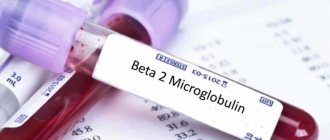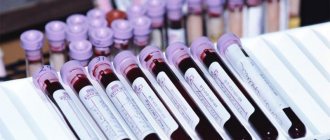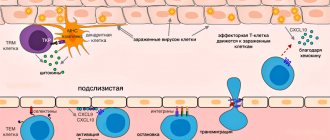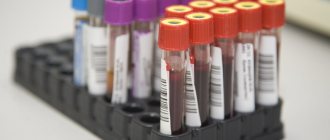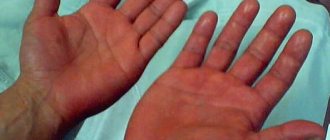Detailed description of the study
B cells, lymphocyte subpopulations and their functions.
Leukocytes or white blood cells provide human immunity and include several groups with different functions and structures. One of these groups includes B lymphocytes (B cells). They play an important role in immunity and their main functions include:
- recognition and analysis of antigens (foreign particles) by special receptors;
- ensuring humoral immunity reactions;
- differentiation into plasmacytes (cells that produce antibodies);
- providing local protection of mucous membranes.
Like the pathology of other leukocytes, such as T lymphocytes, T helper cells, monocytes and eosinophils, B cell deficiency can be congenital or acquired and is characterized by a decrease in the synthesis of immunoglobulins (antibodies). This condition leads to increased susceptibility to infectious agents (bacterial, viral, fungal).
The respiratory system is most often affected.
Blood B cells are formed in the bone marrow and then enter the blood and tissues. During development, CD markers (CD receptors) appear on their surface. They may be common to different cell populations or specific to a particular population. There are a large number of them, and each performs its own function. This study evaluates four types of cells using three markers (CD19, CD5, CD27):
- B lymphocytes (CD19+).
- B1 lymphocytes (CD19+CD5+).
- B2 lymphocytes (CD19+CD5-).
- Memory B cells (CD19+CD5-CD27+)
Research and further interpretation of the analysis are of great importance for the identification and treatment of diseases of the immune system. Thus, CD19+CD5+ contain B1a cells. Their predecessors, even in the embryonic period, move to the abdominal and pleural cavities, where they exist as a self-sustaining population.
The development of B1b lymphocytes is similar, but the number of this phenotype in adults may be partially replenished by bone marrow. These cells (B1a and B1b) provide a rapid response to widespread pathogens, mainly bacteria, that enter the body. Many B1 cells produce antibodies specific to self-antigens. Thymocytes, all mature T lymphocytes, also have CD5.
CD19+CD5- are found on the surface of B2 cells. Before becoming a full-fledged defense of the body, this type of lymphocyte must go through a long stage of differentiation. These cells are distinguished by a large number of functions, a huge range of produced immunoglobulins and make up approximately 95% of the entire population of lymphocytes.
CD19+CD5-CD27+ contain memory B cells. They live in human blood for a long time. Thanks to them, there is a quick response to an infection already “familiar” to the body. Upon contact with a foreign agent, they rush to the red bone marrow, where they turn into other cells and begin to actively fight it. CD27 is also found in T lymphocytes.
Phenotyping of lymphocytes.
CD19+, CD19+CD5-CD27+, CD19+CD5-, CD19+CD5+ and the structures on which they are contained make the immune system work “coherently”, reflect the state of a person’s defense against microorganisms, and their imbalance can be a manifestation of various pathologies.
When analyzing and evaluating a panel of CD receptors in the Hemotest laboratory, the flow cytometry method is used. Phenotyping of lymphocytes makes it possible to separate each indicator included in the study and improve the diagnosis of diseases. The attending physician sees the result in the absolute and relative number of cells, compares the obtained values with the norm and interprets the study.
Interpretation:
- An increase in the level of B-1 cells, B-2 cells and memory B cells is characteristic of: • Autoimmune pathology (systemic lupus erythematosus, rheumatoid arthritis, autoimmune thyroiditis, ulcerative colitis, myasthenia gravis. • Autoimmune lesions in infectious diseases (chlamydia, Reiter's syndrome, brucellosis).• Lymphoproliferative processes.• Acute and chronic bacterial, fungal and parasitic infections.• Chronic liver diseases, cirrhosis.• Chronic lymphocytic leukemia.• Endothelioma, osteosarcoma.• Myeloma.• Waldenström's macroglobulinemia.• Candidiasis, cystic fibrosis. • Asthma, tuberculosis. • Monoclonal gammopathy.
- Decreased levels are observed in primary immunodeficiencies, Sjogren's syndrome, chronic granulomatous disease, bacterial respiratory tract infections, bacterial infections of the gastrointestinal tract, congenital hypogammaglobulinemia or agammaglobulinemia.
Sample result (PDF)
What else is prescribed with this study?
Biochemistry 8 indicators
27.113. Venous blood 1 day
990 RUR Add to cart
HEMOSTASIOGRAM (Coagulogram)
27.4. Venous blood 1 day
RUB 2,020 Add to cart
Immune status (screening) (Phagocytic activity of leukocytes, cellular immunity, total immunoglobulin IgE, immunoglobulins IgA, IgM, IgG)
27.960. Venous blood 3 days
RUR 7,640 Add to cart
Clinical blood test with leukocyte count and ESR (with microscopy of a blood smear to detect pathological changes) (venous blood)
3.9.1. Venous blood 1 day
720 RUR Add to cart
General urine analysis
9.1. Urine 1 day
380 RUR Add to cart
Patient preparation rules
Standard conditions: Fasting period of 8 hours (unless otherwise determined by the doctor). You can drink water. Biomaterial is accepted in accordance with the schedule for taking biomaterial in the ML department of DILA.
On the eve of the study, it is necessary to exclude physical activity (sports training) and smoking. Children under 5 years of age and adults with contraindications for fasting are allowed a light meal of low-fat food at least 2 hours before donating the biomaterial.
You can add this study to your cart on this page
References
- V. L. Bykov. Cytology and general histology. 2002.
- Khaitov, R.M. Allergology and immunology: national guide / ed. R.M. Khaitova, N.I. Ilyina. 2009.
- Afanasyev Yu.I. Histology, embryology, cytology. Textbook. Revised and expanded 6th edition. 2021.
- Immunology: structure and functions of the immune system: textbook / R. M. Khaitov. 2013.
- Immunology and allergology: a textbook for students of medical universities / ed. A. Vorobyova, A.S. Bykova, A.V. Karaulova. 2006
Norms
The normal level of lymphocytes in the blood depends on the age of the patient. In children, the number of lymphocytes is higher; over time, this figure gradually decreases. The number of these cells is influenced by the gender of the patient; in women the indicator is relatively higher. This is due to the greater activity and adaptive capacity of the lymphatic system of the female body.
| Person's age | Absolute content | Ratio in % |
| In a child under one year old | 2-12 | 45-71 |
| In a one-year-old child | 4-10 | 38-61 |
| 2-4 years | 3-9 | 34-50 |
| 4-10 years | 1,6-6,7 | 31-51 |
| 10-18 years | 1,3-5,3 | 31-43 |
| Over 18 years old, adults | 1-4,9 | 20-40 |
| Cancer risk for women: | 265 | 368 |
Functions of NK cells:
The third type of lymphocytes (natural killer cells, NK cells) exists to help the first. In principle, in their functions they duplicate T-lymphocytes. Natural killer cells have the ability to destroy those damaged cells that are inaccessible to the action of T lymphocytes.
Lymphocytes in children are quite “inexperienced”: children’s immunity has not developed its memory very well, because it has not yet encountered a large number of diseases. This is why children are less resistant to various types of adversity than adults. However, even adulthood and maturity does not provide us with invulnerability to bacteria, viruses, etc.
There is a remedy that allows you to “refresh” and strengthen the memory of the immune system. Transfer Factor drug.
. It is of biological origin and contains information molecules that carry information about how the immune system needs to work correctly and how it should react to certain stimuli. A particularly significant effect of the drug is noted in relation to NK cells, the activity of which increases by 283% under the influence of Transfer Factor therapy.
The drug is suitable for patients of different ages and can be used for therapeutic and prophylactic purposes. This is one of the most powerful remedies for improving the functions of lymphocytes, so it is indicated for all people who have problems with the immune system or want to avoid them.
Lymphocytes are increased
The reason why lymphocytes are elevated is often a variety of viral infections. This increase is called lymphocytosis, and is most often recorded in diseases caused by viruses:
- Epstein-Barr.
- Adenovirus.
- Herpes.
- Childhood infections (rubella, measles, mumps).
The number of lymphocytes may increase with some bacterial infections, such as syphilis, whooping cough, or tuberculosis. Diseases caused by protozoa, such as malaria and toxoplasmosis, can lead to lymphocytosis. Often, an increase in lymphocytes is caused by helminthic infestations.
Lymphocytes may be elevated for reasons unrelated to infection. These include:
- Hypersensitivity reactions.
- Stress lymphocytosis.
- Autoimmune diseases.
- Disorders of the endocrine organs, especially the thyroid gland.
- Development of tumors and pretumor processes.
The most striking signs of an increase in the number of lymphocytes include:
- Enlarged liver, spleen and lymph nodes.
- General malaise, manifestations of respiratory infections, redness and swelling of the mucous membranes.
- A sharp increase or decrease in temperature, accompanied by chills.
- Dyspeptic symptoms - vomiting, stool disorders, nausea.
- Nervous system disorders due to elevated temperature.
It should be borne in mind that lymphocytosis does not always manifest itself through severe symptoms. Often, elevated levels of these cells are discovered by chance. Only a doctor can accurately determine the reason why a change in the blood formula occurred; this often requires additional tests.
To eliminate lymphocytosis, you need to cure the disease that led to an increased immune response. It is important to understand that the hematopoietic system responds to recovery with a certain delay. Even after complete recovery, lymphocytosis can persist for up to several months.
Lymphocytes are low
A decrease in lymphocytes is called lymphopenia. This condition is typical for the following diseases:
- AIDS.
- Long-term, severe infections.
- Bone marrow pathologies.
- Tumors of lymphatic tissues.
- Exposure to radiation.
- Taking certain groups of drugs, such as cytostatics.
- Pregnancy.
In most cases, a decrease in the level of lymphocytes indicates a depleted immune system, when the body, for various reasons, is unable to maintain the required level of these cells in the blood.
Lymphopenia rarely presents with characteristic symptoms. The most common signs of this condition include:
- Reduction or complete absence of tonsils and other peripheral lymph nodes.
- Skin diseases - eczema, pyoderma.
- Common signs of blood diseases are ulcers of the oral mucosa, petechiae, pallor, and jaundice.
- Enlarged liver and spleen.
As in the case of lymphocytosis, to normalize the level of these cells, it is necessary to eliminate the cause that led to the pathological condition. You need to see a doctor who can establish an accurate diagnosis and prescribe the correct treatment regimen.
In the case of lymphopenia in pregnant women, with a moderate decrease in the level of lymphocytes, there is no need to take special measures. Enhanced monitoring of your health status and regular completion of all necessary examinations is sufficient. If there is a sharp drop in lymphocytes, you should seek medical help for additional diagnostics.
